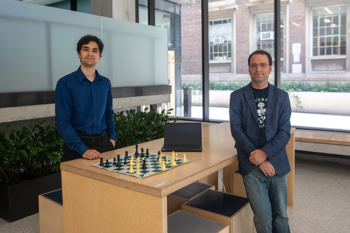The second year of the international AutoDrive Challenge kicks off today in Ann Arbor, Mich., and U of T Engineering’s aUToronto team is looking to defend its first-place title. They’ve made upgrades to Zeus — a converted Chevrolet Bolt EV — to make that happen.
Founded by GM and SAE International, AutoDrive challenges eight universities from across North America to turn an electric Chevy Bolt completely self-driving by 2020. At the inaugural competition last year, aUToronto — a student team comprised of undergraduate and graduate students from across U of T Engineering and Computer Science — came out on top.
This year’s competition will focus on urban environment driving scenarios. “That means this year we had to prepare for static and dynamic objects,” says team lead Keenan Burnett, (EngSci 1T6+PEY, UTIAS MASc candidate). “It’s actually quite a difficult task.”
The teams will have to complete four driving challenges that demonstrate the vehicles’ autonomous capabilities by obeying traffic signs, traffic lights at intersections, as well as navigating pedestrian crosswalks.
The final challenge takes place at MCity — a simulated town built at the University of Michigan for self-driving vehicle testing — and combines all three challenges, while ramping up the difficulty. “MCity has a few additions: a railroad crossing, cyclists, a tunnel and a dynamic animal crossing,” explains Burnett.
To prepare Zeus to handle more advanced sets of self-driving challenges, such as stopping and waiting for pedestrians to cross at intersections, the team designed a lightweight object detection and tracking system, dubbed aUToTrack, which fuses vision and LIDAR (light detection and ranging) together to accurately track the position and velocity of pedestrians and other cars.
The team also upgraded and added more mounted cameras, installed wireless Internet to allow the vehicle to communicate with a GPS (global positioning system) base station, as well as a custom-printed circuit board to synchronize the cameras, LIDAR and GPS.
Matching substance with style, the team has also applied a fancy new wrap to Zeus.
After learning their results on June 4, the team will begin preparing Zeus for Year 3 of the competition. Burnett says the team is already thinking ahead to 2020: “We didn’t want to design our vehicle to be hyper-specialized to Year 2, but rather one that would enable our system to achieve our goal of full autonomy.”



